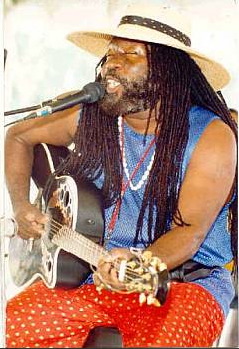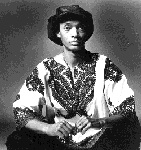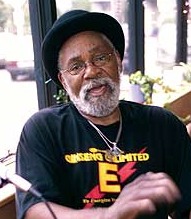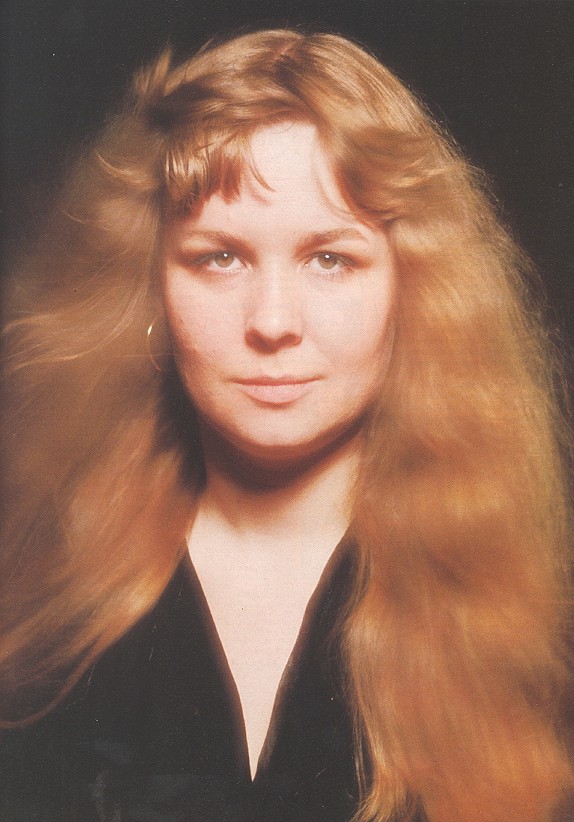 Exuma alias McFarlane Anthony McKay
Exuma alias McFarlane Anthony McKay
Cat Island, Bahamas 18 February 1942 - Nassau, Bahamas 25 January 1997
Exuma, the Obeah Man, was born in Cat Island, Bahamas and christened as Tony McKay; he grew up through Canaan Lane off Shirley Street, Nassau, Bahamas.
Drawing on the traditional Bahamian folk songs, the infectious beat of Junkanoo, ring play, myths and linguistic idioma, Exuma, through his musical recordings, performances and paintings, has promoted Bahamian heritage and extended Bahamian music throughout the world moreso than any other contemporary Bahamian recording artist.
Exuma left The Bahamas in the early 1960's to study architecture in New York. After running out of money, Exuma started to perform around New York during the rising sentiments against the war in Vietnam. Soon thereafter, Exuma started to perform, using Bahamian rhythms in Greenwich Village folk scene. In the village, Exuma often performed along with Bob Dylan, Richie Havens, Peter Paul and Mary, Jimmy Hendrix and Barbra Streisand at the Cafe Wha on Third and McDougal Streets, Cafe Bizarre on McDougal Street and Cafe Bitter End on Bleeker Street all in Manhattan, New York.
Exuma landed his first major recording contract with Mercury Records which released two albums by him: Exuma, the Obeah Man and Exuma II. Later, Exuma signed a recording contract with Budda/Kama Sutra label wich released four albums by Exuma: Reincarnation, Snake, Life, Do Wah Nanny ad the single, "Bam Bam". In pursuit of artistic independence, Exuma established his own record producing label, Nassau Record, through which he released Rude Boy, Going to Cat Island. In the early seventies a song from Exuma's first album entitled "You Don't Know What's Going On" was used on the soundtrack of the movie Joe that starred Peter Boyle and Susan Sarandon. Exuma's compositions and arrangements are also very much in demand by other top artists. For example, Nina Simone recorded three of Exuma's compositions: "Obeah Woman", "22nd Century" and "Dambala". Also, Jimmy Castor Bunch recorded Exuma's compositions: "Bam Bam" and "Do Wah Nanny". Many contemporary Bahamian recording artists, including Eugene Davis and the National Youth Choir, have recorded and performed many of Exuma's compositions such as "Going to Cat Island", "Exuma, the Obeah Man" and "Bam Bam".
As a performance artist, Exuma has carried the unique Junkanoo sounds in his arrangements and pictures of Bahamian cultural life, folklore and myths in his lyrics to the major concert halls of the worls. Exuma has performed at Avery Fisher Hall in New York, opening the show for Patty LaBelle; at the Bitter End Club in New York City with Curtis Mayfield; opened for Rita Marley at the New Orleans Jazz Festival and at the River Boat President; toured with Peter Tosh; performed with Toots and the Maytells at the New Orleans Jazz Festival; opened many times for Sly and the Family Stone, Steppenwolf, X and Black Flag. Between the years 1978 through 1991 Exuma performed each year at the New Orleans Jazz Festival and regularly performed and toured with the Neville Brothers. In 1974 Exuma was invited by the Queen of Holland to perform for her with the Edwin Hawkins Singers. Under the patronage of the then Prime Minister of Jamaica, Honourable Michael Manley, Exuma was invited to perform in Jamaica in the National Arena in 1975, where he was invited to record a reggae album, under the direction of Mr. Clancy Eckles, in collaboration with some of the leading Jamaican recording artists. In 1982 Exuma was invited to perform at the Nancy Jazz Festival in Nancy, France, along with the Neville Brothers.
Exuma's contribution to Bahamian and Caribbean music was recognised by Her Majesty Queen Elizabeth II in 1978 when she awarded him the British Empire Medal. Exuma is also the recipient of The Bahamas Tourism Award.
As a self taught painter, Exuma paints in oils scenes of everyday Bahamian life -- children shooting marbles in the yard, a man on the dock enjoying a kalik beer, etc. In 1992 the Baltimore Museum authenticated Exuma as a folk artist. His paintings have been exhibited in 1990 at the Key West Lucky Street Gallery in Florida, in 1990 at the Piccadilly Restaurant, Parliament Street, Nassau, Bahamas and in 1993 by Mr. Antonius Roberts at the Bag Gallery, Bay Street, Nassau, Bahamas. Exuma's paintings have been purchased by many art lovers, including the well know movie director, John Demme, director of Silence of the Lambs. Exuma conveys the mystique and beauty of Bahamian life as stunningly in painting as in song.
A Bahamian visionary, humanistic philospher and people's poet, Exuma gives expression to the beauty and power of the cultural life of the Bahamas -- the people's every day experiences, folklore, myths, stories, junkanoo, rake and scrape, pain, joy, struggle and survival. His life and art reflect the wonderful cultural heritage and personality of Bahamians, drawing on the roots of Africa and the branches of the Amerindians, Europeans and Americans.
-Alfred M. Sears, 7th September, 1995
On 12 February 1997 Susan Maloney sent me above bio and this mail:
-
I don't know if you have personal contact with Nina Simone, but I did not know if she was aware that a friend of her's passed away three weeks ago. Exuma, the Bahamas best known singer and songwriter was buried in Nassau on January 25th. Exuma loved her voice and her person, he lit up whenever he spoke of her and he was so proud that she had recorded three of his compositions [Obeah Woman, Dambala, 22nd Century] during the sixties and seventies.
He recorded nine albums and I am doing a commemorative tape to send to his friends to remind them just how wonderful he was, and continues to be. Exuma is Tony McKay's Stage Name, or if you prefer nome de plume, because he also signed paintings that way.
Actually his full stage name is Exuma the Obeah Man, and in the Bahamas they would either call him Exuma or The Obeah Man or Tony, but his real name is McFarlane Anthony McKay, (or Mackey) now that I've completely confused you.
He recorded nine albums from the 60's - 80's when he passed away he had three dat albums which were never made into CD's or tapes, his new music was wonderful, but he just did not have proper backing. Hopefully soon his daughter Kenyatta, who worked with him on his last double record set last year will have them produced. They are very contemporary, and different very new and fresh.
Exuma in Wikipedia
Biography in Musicians & Entertainers of the Bahamas
 Weldon Irvine
Weldon Irvine
Hampton, Virginia 27 October 1943 - Uniondale, New York, 9 April 2002
Weldon Irvine collaborated with Nina for several years starting in 1968. During this time he was not only one of her musicians but also co-wrote several songs with her, including "To Be Young, Gifted and Black" and "Revolution". Irvine recalls his 'audition' as an organist with Simone as follows:
I went to the audition and got there an hour late. I walked in and said, 'Ms Simone, I'm sorry I'm late.' She said, 'I don't want to hear that shit. Sit down and turn the damn thing up so I can hear your ass.' She was in the middle of a twelve bar blues in B flat. I turned up the organ and jumped in there with one chord, and she said, 'Stop! You have perfect pitch.'
Simone then sent everyone out of the room except Irvine. She looked him in the eyes and asked a series of questions, some of which were highly personal. She must have been pleased with the answers because he got the job. Irvine said, 'I only played one chord for her. It was amazing.'
Their collaboration ended after about three years but Irvine refused to say anything negative about Simone except to state, 'She is very difficult'.
Weldon Irvine killed himself at the age of 59 in 2002.
-Stephen G, Nina Simone Forum
Weldon Irvine in Wikipedia
Biography in iTunes
 Umbopha Emile Latimer
Umbopha Emile Latimer
Buffalo
In the sixties a Greenwich Village open mike. Guys like Richie Pryor, Bill Cosby, and Jimmy Hendrix are there, as well as Richie Havens, who will tour and record with some guy banging a big blue drum—really good, tireless. His name is Latimer.
“I went to work with Richie and never looked back,” the drummer says. “We used to play damned near all night long. Six or seven sets a night. Jump from this coffee house, run over to this one, do a set, run over to that one, do a set. That’s how you pay your rent. Wasn’t easy.”
Around this time, the great singer Nina Simone is looking for a guitar player. She auditions Latimer. Simone and Latimer, it turns out, have both written a song called Black is the Color of My True Love’s Hair. “You played and wrote what I wanted to write,” says Simone. “You’ll sing that in my show.”
They tour the coast. Play L.A., Montreal, Europe. Then back to New York, in 1969, with a twist: “Here’s a New York guy, only played down at 44th street,” Latimer recalls. “Now I’m with this superstar, at Lincoln Center, now I’m really scared. She never told us she was going to record that night. It was sold out. I was nervous; I made a mistake. I started all over again, and I was so determined. I can play this. This is mine. I wrote it. So I played it the second time, man, there was screaming applause. She looked at me: Take a bow. She was all happy.” The record, Black Gold, is released—with Latimer’s mistake edited out.
Over the years, Latimer also records with Gamalon, Spyro-Gyra, and one of his own bands—on the CD Emile Latimer With Abundance. He tours the world and performs at the Montreaux Jazz and Pop Festivals of the Netherlands and Switzerland and the Newport Jazz Festival. In 2000, he is inducted into the Buffalo Musicians Hall of Fame.
 Sandy Denny alias Alexandra Elene McLean Denny
Sandy Denny alias Alexandra Elene McLean Denny
London, 6 January 1947 - 21 April 1978
English folksinger. Sandy Denny was born in London and grew up in suburban Wimbledon in 1947, shortly after the second world war. She began playing piano and guitar at an early age. She was a lazy student and would always get her teacher to first play any piece assigned for practice. The suspicious teacher began including deliberate mistakes in her preliminary performances and when they appeared note for note in Sandy's renditions the following week, the truth came out-Sandy was not learning to read music, she was playing everything by ear from memory.
She left nursing course at college to start pursuing a career as a folk singer. Performing both American singer-songwriter and British traditional styles, her powerful voice soon gained her a reputation in the small pubs and clubs of the folk "circuit" in England in the mid-'60s. She was invited to sing in a BBC radio broadcast that led to a record deal with Saga Records, and she released "It's Sandy Denny". Those days, Dave Cousins was preparing the first Strawbs lp and asked Sandy to join them. She recorded "All Our Own Work" with them in 1967 as Sandy and the Strawbs, and the album was released six years later, in 1973. One of the songs from that record, "Who Knows Where The Time Goes?" was heard in the US by Judy Collins and recorded on her lp of the same name. Only the second song Sandy ever wrote, it has now become a classic.
In 1968, Sandy was invited to replace Judy Dyble in the Fairport Convention and set sail for the earliest climes of English folk-rock tugging the group away from their leanings towards American folk. Her lively and boisterous personality had an immediate effect on the rather quiet, self-effacing Fairports. Her songs and singing added a new dimension to their sound and she spurred particularly Richard Thompson into a more adventurous and unique style of playing and songwriting. Following the success of the group's next two lps, "What We Did On Our Holidays" and "Unhalfbricking", they were preparing their first American tour when, returning from a concert from Birmingham, their van overturned on the highway and the drummer, Martin Lamble and Jeannie, The Taylor, Richard's girlfriend were killed.
Later that year they re-formed adding Dave Mattocks on drums and Dave Swarbrick on violin. Swarbrick had first played with the Fairport when they recorded a traditional song Sandy had taught them, "A Sailor's Life". That recording was to prove a watershed in what is now known as "British folk- rock", combining the San Fransisco-influenced quasi-psychedelic instrumentals with the revivalist/traditional folk approach of Sandy and Swarbrick and the strict-tempo jazz flavoured dance-band drumming of Mattacks. The band turned away from American influences for their new album and recorded the historic "Liege & Lief" album which began where "A Sailor's Life" left off and remains to this day the best selling and most influential British folk-rock recording.
In 1970, bassist Ashley Hutchings left Fairport to form Steeleye Span and Sandy left to form Fotheringay with her husband-to-be Trevor Lucas. After one outstanding album, the group broke up and Sandy began a series of solo recordings. She released four solo albums, the haunting "The North Star Grassman And The Ravens", and "Sandy", the lushly orchestrated "Like An Old Fashioned Waltz" which features some some jazz standards of fifties, and her own jazzy compositions, and finally "Rendezvous", a rockier album. In 1974 she rejoined Fairport Convention for the albums "Fairport Live" and the beautifully crafted "Rising For The Moon" albums.
During this periodi Sandy achieved something resembling the acclaim she deserved. She won many readers and critics polls as "Female Vocalist of the Year" from Melody Maker and other magazines. Led Zeppelin asked her to sing on "Battle of Evermore" and she joined many other top stars on a recording of "Tommy".
In 1977 she gave birth to a daughter, Georgia, who now lives in Melbourne, Australia with Trevor. In 1978 Sandy fell down a flight of stairs and died a week later without having regained consciousness.
-Levent Varlik, 13 June 1977
Nina Simone covers "Who Knows Where the Time Goes?" at the Second Jazz Festival on June 16, 1968 in Montreux (unpublished) and on October 26, 1969 in New York, Philharmonic Hall, on her album <i>Black Gold</i> (1970)
Don Alias
New York, 25 December 1939 - 29 March 2006
American jazz drummer and percussionist, Don joined Nina Simone and became her Musical Director during the last of his three years with her group. He has recorded with Nina on the albums To Love Somebody, Here Comes the Sun, A Very Rare Evening.
Hoyt Axton
Duncan, Oklahoma, 25 March 1938 - Victor, Montana, 26 October 1999
Folksinger and songwriter. In the late sixties, his song The Pusher were immortalized by the metal band Steppenwolf and used in movie Easy Rider (1969). Nina also recorded the song.
King Curtis alias Curtis Ousley
Fort Worth, Texas, 7 February 1934 – New York, 13 August 1971
Tenor sax, was born Curtis Ousley on 7 February 1934 in Fort Worth, Texas and was murdered in New York City on 13 August 1971.
Screamin Jay Hawkins
Cleveland, Ohio 18 July 18 1929 - Paris, France 12 February 2000
Alias Jalacy J. Hawkins, composer of "I Put a Spell on You" .
Langston Hughes
1 February 1902 - 22 May 1967
James Mercer Langston Hughes. American poet, short story writer, novelist, playwright, autobiographer, and nonfiction writer. Wrote the lyrics to "Backlash Blues".
Clint Houston bass player
New Orleans, Louisiana 26 June 1946 - New York 6 June 2000
He was born Clinton Joseph Houston in New Orleans, but the family moved north to Washington, DC, when he was three, and then to New York City in 1953. His father played classical piano and his sister guitar, but his own inclinations led him to the acoustic bass. He studied with Ron Carter, then the bassist in Miles Davis’s legendary quintet, in 1964-66, and also studied piano and harmony at Queen’s College in New York, a foundation he put to good use in his playing. He studied graphic art for a time as well, but eventually settled on music.
In the late 1960s he was part of the house band with pianist George Cables and drummer Lenny White, both boyhood friends of his, at the infamous Slugs, a saloon which was friendly to the developing free jazz scene as well as more conventional styles. He gained a valuable grounding there, and had the chance to work with a diverse range of players and styles.
His playing began to attract notice, and he worked with Nina Simone in 1969, and with drummer Roy Haynes in 1969-70, before linking up with a group of musicians, including saxophonist Dave Liebman, to form Free Life Communications, a collective devoted to promulgating free jazz.
from The Last Post
Abbey Lincoln
Chicago, 6 August 1930
Jazz vocalist Anna Marie Wooldridge. Nina and Abbey wrote together the song "Blues for Mama", also known as "Hey, Lordy Mama".
Percussionist, see also All-Music Guide.

Al Schackman
Guitarist and musical director for Nina, has performed and recorded with Dinah Washington, The Drifters, Carole King, Miriam Makeba, Ben E. King, Sarah Vaughan and Burt Bacharach.
Gene Perla
Woodcliff Lake, NJ, USA 1 March 1940
Bassist and keyboard player, Gene Perla has recorded with Nina on the albums To Love Somebody, Here Comes the Sun, A Very Rare Evening.
Gene Perla on Wikipedia

Andrew Stroud Nina's second husband
Virginia 1926 - Riverdale 14 July 2012
Andrew "Andy" B. Stroud, longtime resident of Skyview, died on July 14 at the Schervier Nursing Care Center in Riverdale. He was 86.
Born on a family farm in Virginia, Mr. Stroud is the seventh of eight children and the fifth son of a fifth son. In 1926, Mr. Stroud's family moved to Hudson, N.Y., where he grew up during the Great Depression, working odd jobs before and after school to help support his family, according to wife Scarlett Stroud.
In June 1942, at age 16, Mr. Stroud's father took him to get a summer job at a government warehouse construction site in Schenectady, N.Y. Mr. Stroud remained in Schenectady on his own and continued his music studies in the local high school, focusing on trumpet. In order to support himself, he was also a member of a student dance band.
Mr. Stroud graduated in June 1944 and was drafted the following month. He entered the U.S. Navy and trained at the Great Lakes training facility where he was assigned to the drum and bugle corps. He was then transferred to one of the navy bands assigned to the Naval Airfields in Pensacola, Fla.
Honorably discharged in 1946, Mr. Stroud moved to New York City where he played trumpet on an album recording and at the Apollo Theater with singer Lil' Green. He also performed with various bands including the Mercer Ellington band at the Savoy Ballroom for two weeks and one-nighters in the New York area with the Louis Russell band, according to Ms. Stroud.
On July 1, 1948, Mr. Stroud joined the New York City Police Department as a uniformed patrolman in Harlem. He was promoted to detective in 1951 for outstanding arrests and promoted to Supervising Detective-Sergeant in 1957. He passed the Lieutenant exam while attending the NYPD Science Program at City College and earned 23 citations for apprehension of major criminals.
In 1955, Mr. Stroud married Bella Alonzo; they had three children, Celeste (died at 18 months), Andrew Jr. and Renaldo. They were divorced in 1961.
In March of 1961, Mr. Stroud was introduced to singer Nina Simone; they were married on December 4, 1961 and on September 12, 1962, became parents of daughter Lisa Celeste, according to Ms. Stroud.
In February 1963, Mr. Stroud resigned from the NYPD, just four months short of being promoted to lieutenant, to assume management of Nina's career. He arranged for a very successful concert tour of colleges during the 1960s, as well as her first international tour in 1965 which resulted in her becoming an international success. They divorced in 1970. In July 1970, Mr. Stroud met his current wife, Scarlett Paradies.
In 1974, Mr. Stroud joined a consortium to rebuild the Howard Theater in Washington D.C., the counterpart to the Apollo Theater in New York. Mr. Stroud was selected president of the group, which obtained a government grant to underwrite the restoration of the famed theater which reopened in the spring of 1975 with The Redd Foxx Show.
In 1976, Andy obtained a New York State Private Investigator's license and within two years established a very successful investigation agency with his wife Scarlett, Ms. Stroud said. They retired in 2001 and began to spend their winters in St. Thomas.
In retirement, Mr. Stroud wrote a photo book, Nina Simone: Black Is the Color, depicting their family life together. He also produced a DVD Nina Simone College Concerts & Interviews as well as a number of CDs.
"Andy Stroud was a forceful and authentic figure in life who is dearly loved and will be missed. His light will shine forever in our hearts," his wife, Scarlett Stroud, wrote.
Andrew B. Stroud is survived by his wife of 42 years, Scarlett, his sons Andrew Jr., Renaldo; daughter Lisa Celeste; 10 grandchildren and one great grandchild; nieces Lydia Morris and Joyce E. Stroud; and nephew Jerry Stroud.
Services were held at St. Martin's Episcopal Church in Harlem on July 19.
from The Riverdale Press

